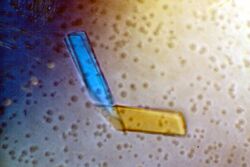Medicine:Bence Jones protein
Bence Jones protein is a monoclonal globulin protein or immunoglobulin light chain found in the urine, with a molecular weight of 22–24 kDa.[1] Detection of Bence Jones protein may be suggestive of multiple myeloma,[2] or Waldenström's macroglobulinemia.[citation needed]
Bence Jones proteins are particularly diagnostic of multiple myeloma in the context of target organ manifestations such as kidney failure, lytic (or "punched out") bone lesions, anemia, or large numbers of plasma cells in the bone marrow. Bence Jones proteins are present in 2/3 of multiple myeloma cases.[3]
The proteins are immunoglobulin light chains (paraproteins) and are produced by neoplastic plasma cells. They can be kappa (most of the time) or lambda.[3] The light chains can be immunoglobulin fragments or single homogeneous immunoglobulins. They are found in urine as a result of decreased kidney filtration capabilities due to kidney failure, sometimes induced by hypercalcemia from the calcium released as the bones are destroyed, dehydration due to polyuria, amyloidosis or from the light chains themselves.[citation needed] The light chains were historically detected by heating a urine specimen (which causes the protein to precipitate) and nowadays by electrophoresis of concentrated urine.[4] More recently, serum free light chain assays have been utilised in a number of published studies which have indicated superiority over the urine tests, particularly for patients producing low levels of monoclonal free light chains, as seen in nonsecretory multiple myeloma[5][6][7] and amyloid light chain amyloidosis (AL amyloidosis).[7][8][9][10]
History
The Bence Jones protein was described by the English physician Henry Bence Jones in 1847 and published in 1848.[11]
References
- ↑ Bernier, G. M. & Putnam, F. W. (1963). Nature (London), 200, 223±225.
- ↑ Anderson, Alyssa. "What Is a Bence-Jones Protein Test?" (in en). https://www.webmd.com/cancer/multiple-myeloma/what-is-bence-jones-protein-test.
- ↑ Jump up to: 3.0 3.1 Essential Haematology (Essential) (5th ed.). Blackwell Publishing Professional. 2006. p. 218. ISBN 978-1-4051-3649-5. https://archive.org/details/essentialhaemato00hoff.
- ↑ "Bence Jones Protein Test". https://medical-dictionary.thefreedictionary.com/Bence+Jones+Protein+Test.
- ↑ "Serum free light-chain measurements for identifying and monitoring patients with nonsecretory multiple myeloma". Blood 97 (9): 2900–2. May 2001. doi:10.1182/blood.V97.9.2900. PMID 11313287.
- ↑ Shaw GR (August 2006). [1212:NPCMEM2.0.CO;2 "Nonsecretory plasma cell myeloma--becoming even more rare with serum free light-chain assay: a brief review"]. Archives of Pathology & Laboratory Medicine 130 (8): 1212–5. doi:10.5858/2006-130-1212-NPCMEM. PMID 16879026. http://www.archivesofpathology.org/doi/10.1043/1543-2165(2006)130[1212:NPCMEM]2.0.CO;2.
- ↑ Jump up to: 7.0 7.1 "Diagnostic performance of quantitative kappa and lambda free light chain assays in clinical practice". Clinical Chemistry 51 (5): 878–81. May 2005. doi:10.1373/clinchem.2004.046870. PMID 15774572.
- ↑ "Outcome in systemic AL amyloidosis in relation to changes in concentration of circulating free immunoglobulin light chains following chemotherapy". British Journal of Haematology 122 (1): 78–84. July 2003. doi:10.1046/j.1365-2141.2003.04433.x. PMID 12823348.
- ↑ "Quantitative analysis of serum free light chains. A new marker for the diagnostic evaluation of primary systemic amyloidosis". American Journal of Clinical Pathology 119 (2): 274–8. February 2003. doi:10.1309/LYWM-47K2-L8XY-FFB3. PMID 12579999.
- ↑ "Quantitative serum free light chain assay in the diagnostic evaluation of AL amyloidosis". Amyloid 12 (4): 210–5. December 2005. doi:10.1080/13506120500352339. PMID 16399645.
- ↑ Jones HB (1848). "On a new substance occurring in the urine of a patient with mollities ossium". Philosophical Transactions of the Royal Society 138: 55–62. doi:10.1098/rstl.1848.0003.
 |


